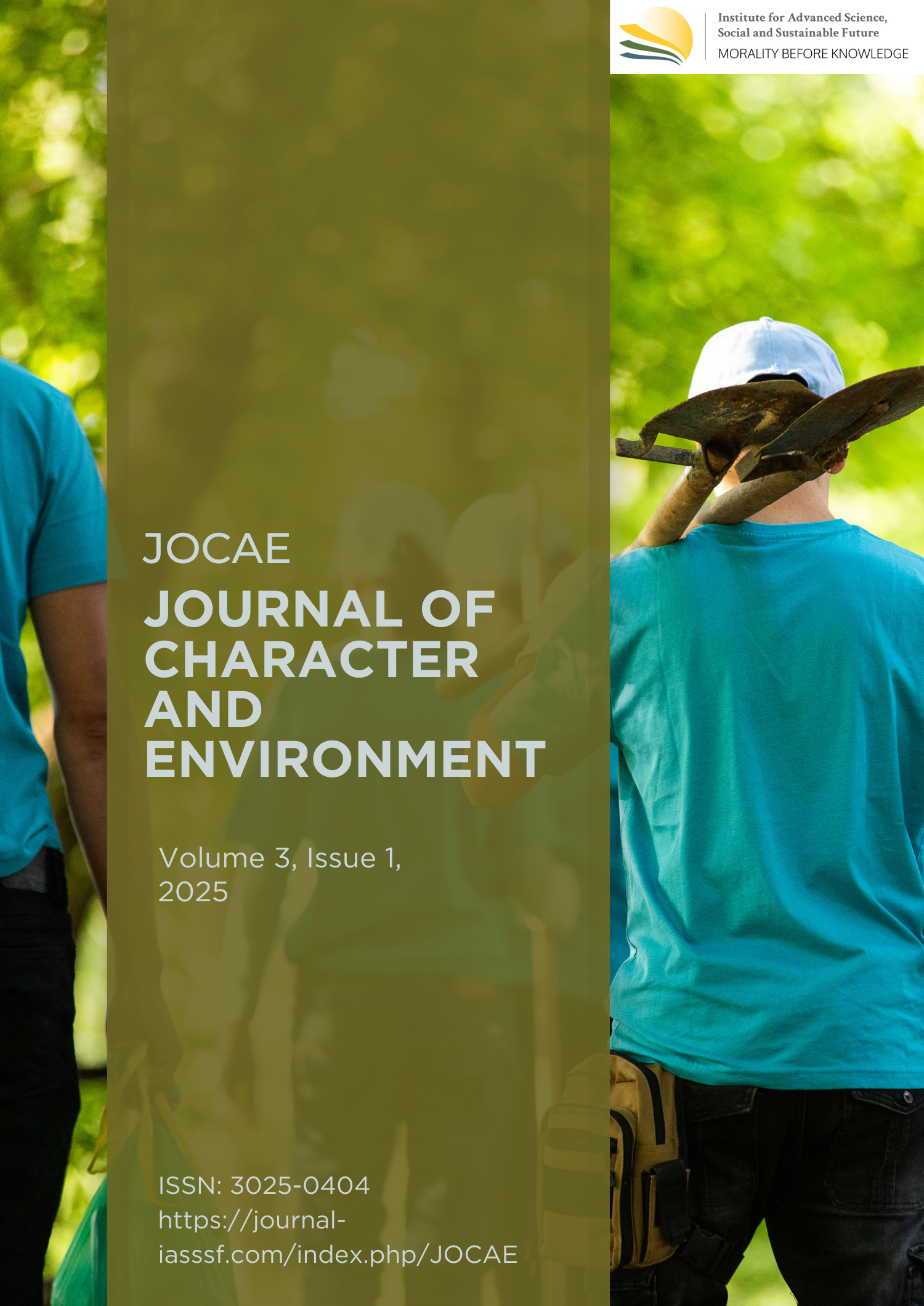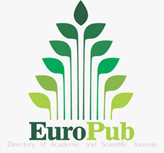The contribution of local wisdom of the Baduy community to nature conservation: An ethnographic study based on ecological and customary perspectives
DOI:
https://doi.org/10.61511/jocae.v3i1.2025.1830Keywords:
nature, Baduy, environment, community, valuesAbstract
Background: This study analyzes the cultural relations of the Baduy community in their efforts to conserve nature using a qualitative approach based on ethnography. Methods: Data was collected through non-participatory observation and unstructured interviews with nine informants from the Baduy indigenous community in Banten. The analysis uses social ecology theory and customary law. Findings: The results show that the Baduy community consistently practices norms, spirituality, and nature conservation that have been passed down by their ancestors, even as globalization and modernism sweep through. The findings show that the Baduy community possesses ecological wisdom that functions as a form of local environmental governance, integrating spiritual values with environmental ethics. Their resistance to modernization and industrialization is not a rejection of progress, but a conscious effort to maintain the balance between humans and nature in accordance with traditional values. Conclusion: This research, grounded in local wisdom, not only deepens readers' understanding of the Baduy indigenous community's role in preserving cultural identity while conserving nature but also aids in the design of government policies. Novelty/Originality of this article: This research expands on previous studies by highlighting the spiritual aspect of the Baduy indigenous community as an important ecological actor that has received little attention in studies of indigenous ecology.
References
Adlini, M. N., Dinda, A. H., Yulinda, S., Chotimah, O., & Merliyana, S. J. (2022). Metode penelitian kualitatif studi pustaka. Edumaspul: Jurnal Pendidikan, 6(1), 974–980. https://doi.org/10.33487/edumaspul.v6i1.3394
Ananta, A., Arifin, E. N., Hasbullah, M. S., Handayani, N. B., & Pramono, A. (2015). Demography of Indonesia's ethnicity. Institute of Southeast Asian Studies (ISEAS) Publishing.
Asia-Pacific Economic Cooperation. (2021). Case studies on advancing inclusive economic growth: Understanding and valuing indigenous economies within APEC. Asia-Pacific Economic Cooperation.
Asteria, D., Brotosusilo, A., Negoro, H. A., & Sudrajad, M. R. (2021a). Contribution of customary law in sustainable forest management for supporting climate action. IOP Conference Series: Earth and Environmental Science, 940(1), 012080. https://doi.org/10.1088/1755-1315/940/1/012080
Asteria, D., Brotosusilo, A., Soedrajad, M. R., & Nugraha, F. N. (2021b). Adat law and culture: The local authority elements of Baduy tribe on environment preservation. IOP Conference Series: Earth and Environmental Science, 716, 1–7. https://doi.org/10.1088/1755-1315/716/1/012049
Basso, K. H. (1996). Wisdom sits in places: Landscape and language among the Western Apache. University of New Mexico Press.
BPS. (2023). Indonesia environment statistics 2023. Central Bureau of Statistics.
BPS. (2024a). Statistics Indonesia: Statistical yearbook of Indonesia 2024. Central Bureau of Statistics.
BPS. (2024b). Tribal profile and regional language diversity: Results of the 2020 population census long form. Central Bureau of Statistics.
Butler, A., & Sinclair, K. A. (2020). Place matters: A critical review of place inquiry and spatial methods in education research. Review of Research in Education, 44(1), 64–96. https://doi.org/10.3102/0091732X20903303
Cantika, V. M., Hernawan, A. H., & Dewi, L. (2024). Pendidikan masyarakat adat dalam kerangka kurikulum Indonesia. Ideguru: Jurnal Karya Ilmiah Guru, 10(1), 682–690. https://doi.org/10.51169/ideguru.v10i1.1600
Creswell, J. W., & Creswell, J. D. (2018). Research design: Qualitative, quantitative, and mixed methods approaches (5th ed.). SAGE Publications, Inc.
Darisera, S. I., Letedara, R., Latue, P. C., & Rakuasa, H. (2024). Rekonstruksi hukum adat dalam penegakan hukum lingkungan di Indonesia: Studi literatur dari perspektif global dan lokal. Rechtsvinding, 2(1), 33–38. https://doi.org/10.59525/rechtsvinding.v2i1.411
Dupuy, P.-M., Moli, G. L., & Viñuales, J. E. (2018). Customary international law and the environment. Cambridge Center for Environment, Energy and Natural Resource Governance.
Durkheim, E. (1995). The elementary forms of religious life. The Free Press.
Fairholm, G. W. (2000). Capturing the heart of leadership: Spirituality and community in the new American workplace. Praeger, Greenwood Publishing Group.
Hall, S., & Liebenberg, L. (2024). Qualitative description as an introductory method to qualitative research for master's-level students and research trainees. International Journal of Qualitative Methods, 23, 1–5. https://doi.org/10.1177/16094069241242264
He, H. (2020). The impact of globalization on indigenous cultures. International Journal of Business, Management and Visuals, 3(2), 7–12. https://ijbmv.com/index.php/home/article/view/38
Huraerah, A., Nurwulan, R. L., & Voo, P. (2023). Local culture-based community development in Subang Regency, West Java. Empathy: Journal of Social Welfare Science, 12(1), 27–32. https://doi.org/10.15408/empati.v12i1.31786
Iqbal International Institute for Research & Dialogue. (2011, November 17–18). Globalization and its impact on indigenous cultures. Iqbal International Institute for Research & Dialogue. https://www.iiu.edu.pk/institutesacademies-libraries/ird-home/
Khangura, R., Ferris, D., Wagg, C., & Bowyer, J. (2023). Regenerative agriculture—A literature review on the practices and mechanisms used to improve soil health. Sustainability, 15(3), 1–41. https://doi.org/10.3390/su15032338
Kleespies, M. W., & Dierkes, P. W. (2020). Exploring the construct of relational values: An empirical approach. Frontiers in Psychology, 11(209), 1–14. https://doi.org/10.3389/fpsyg.2020.00209
Kompas.com. (2022, March 2). Seba ceremony of Baduy tribe: History, purpose, and implementation. Kompas.com. https://regional.kompas.com/read/2022/03/02/150117878/upacara-seba-suku-baduy-sejarah-tujuan-dan-pelaksanaan?page=all
Kusumastuti, A., & Khoiron, A. M. (2019). Qualitative research methods. Sukarno Pressindo Institute of Education.
Lestarini, R., Tirtawening, T., Harmain, R., Wulandhary, S., & Utari, D. (2018). The implementation strategy of customary law aspect in protecting local environment. E3S Web of Conferences, 52, 00041. https://doi.org/10.1051/e3sconf/20185200041
Maculan, E., & Gil, A. G. (2020). The rationale and purposes of criminal law and punishment in transitional contexts. Oxford Journal of Legal Studies, 40(1), 132–157. https://doi.org/10.1093/ojls/gqz033
McGregor, D. (2021). Indigenous knowledge systems in environmental governance in Canada. KULA: Knowledge Creation, Dissemination, and Preservation Studies, 5(1), 1–10. https://doi.org/10.18357/kula.148
Melash, A. A., Bogale, A. A., Migbaru, A. T., Chakilu, G. G., Percze, A., Abraham, E. B., & Mengistu, D. K. (2023). Indigenous agricultural knowledge: A neglected human-based resource for sustainable crop protection and production. Heliyon, 9(1), 1–9. https://doi.org/10.1016/j.heliyon.2023.e12978
Menzies, A. K., Bowles, E., McGregor, D., Ford, A. T., & Popp, J. N. (2024). Sharing indigenous values, practices and priorities as guidance for transforming human-environment relationships. People and Nature, 6(5), 2109–2125. https://doi.org/10.1002/pan3.10707
Ministry of Environment and Forestry of the Republic of Indonesia. (2022). Indonesia's environmental status 2022. Ministry of Environment and Forestry of the Republic of Indonesia.
Mirajiani, S., Sulaeni, & Sutisna, T. (2019). The local farming system based on custom and tradition to achieve sustainable agriculture in Baduy indigenous community. IOP Conference Series: Earth and Environmental Science, 383, 1–8. https://doi.org/10.1088/1755-1315/383/1/012032
Nassaji, H. (2016). Qualitative and descriptive research: Data type versus data analysis. Language Teaching Research, 19(2), 129–132. https://doi.org/10.1177/1362168815572747
Neeganagwedgin, E. (2013). Ancestral knowledges, spirituality and indigenous narratives as self-determination. AlterNative: An International Journal of Indigenous Peoples, 9(4), 322–334. https://doi.org/10.1177/117718011300900404
Nugroho, K. S., Ardiansyah, & Sjafari, A. (2024). "Here" collaborative governance: Tourism development model of the Baduy indigenous people in Indonesia. Journal of Law and Sustainable Development, 12(1), 1–23. https://doi.org/10.55908/sdgs.v12i1.2823
Nwocha, M. E. (2016). Customary law, social development and administration of justice in Nigeria. Beijing Law Review, 7(4), 430–442. https://doi.org/10.4236/blr.2016.74034
O'Gorman, M. (2024). Explaining educational achievement among indigenous individuals: How important are culture and language? Education Economics, 1–37. https://doi.org/10.1080/09645292.2024.2387586
Perreau-Saussine, A., & Murphy, J. B. (2007). The nature of customary law. Cambridge University Press.
Putra, D. S. (2023, October 22). Ngaseuk, a rice planting tradition of Baduy indigenous people. Journey of Indonesia. https://journeyofindonesia.com/travel/tourism/ngaseuk-sebuah-tradisi-tanam-padi-masyarakat-adat-suku-baduy/
Schuster, R., Germain, R. R., Bennett, J. R., Reo, N. J., & Arcese, P. (2019). Vertebrate biodiversity on indigenous-managed lands in Australia, Brazil, and Canada equals that in protected areas. Environmental Science and Policy, 101, 1–6. https://doi.org/10.1016/j.envsci.2019.07.002
Senoaji, G. (2010). Masyarakat Baduy, hutan, dan lingkungan. Jurnal Manusia dan Lingkungan, 17(2), 113–123. https://doi.org/10.22146/jml.18710
Setyowati, S. (2006). Etnografi sebagai metode pilihan dalam penelitian kualitatif di keperawatan. Jurnal Keperawatan Indonesia, 10(1), 35–40. https://doi.org/10.7454/jki.v10i1.171
Sirait, M., Fay, C., & Kusworo, A. (2022). How the rights of indigenous peoples in managing natural resources are regulated. The Center for International Forestry Research and World Agroforestry.
Sodikin. (2006). Environmental wisdom in Baduy community. Universitas Indonesia.
Suina, S. (2000). Linking native people around the spirituality of all life: “The gifts of our grandmothers and grandfathers.” In M. K. Benham & J. E. Cooper (Eds.), Indigenous educational models for contemporary practice: In our mother's voice (pp. 93–100). Routledge.
Tangdialla, R., Wibisono, L. K., & Panggalo, I. S. (2022). Strategic design of indigenous community economic development in North Toraja Regency in accelerating national development. INFLUENCE: International Journal of Science Review, 4(2), 203–211. https://doi.org/10.36080/influence.v4i2.54
Triko, G., Hapsari, D. R., & Matindas, K. (2022). Digital media information literacy in indigenous communities in the Internet of Things (IoT) era: Case study of the Outer Baduy indigenous community in Kanekes Village, Leuwidamar District, Lebak Regency, Banten Province. Journal of Development Communication, 20(2), 125–139. https://doi.org/10.46937/20202241086
Vidich, A. J., & Lyman, S. M. (2000). Qualitative methods: Their history in sociology and anthropology. In N. K. Denzin & Y. S. Lincoln (Eds.), The handbook of qualitative research (2nd ed., pp. 37–84). Sage Publications.
World Intellectual Property Organization. (2016). Customary law and traditional knowledge. World Intellectual Property Organization.
Downloads
Published
How to Cite
Issue
Section
Citation Check
License
Copyright (c) 2025 Sidik Permana

This work is licensed under a Creative Commons Attribution 4.0 International License.
















